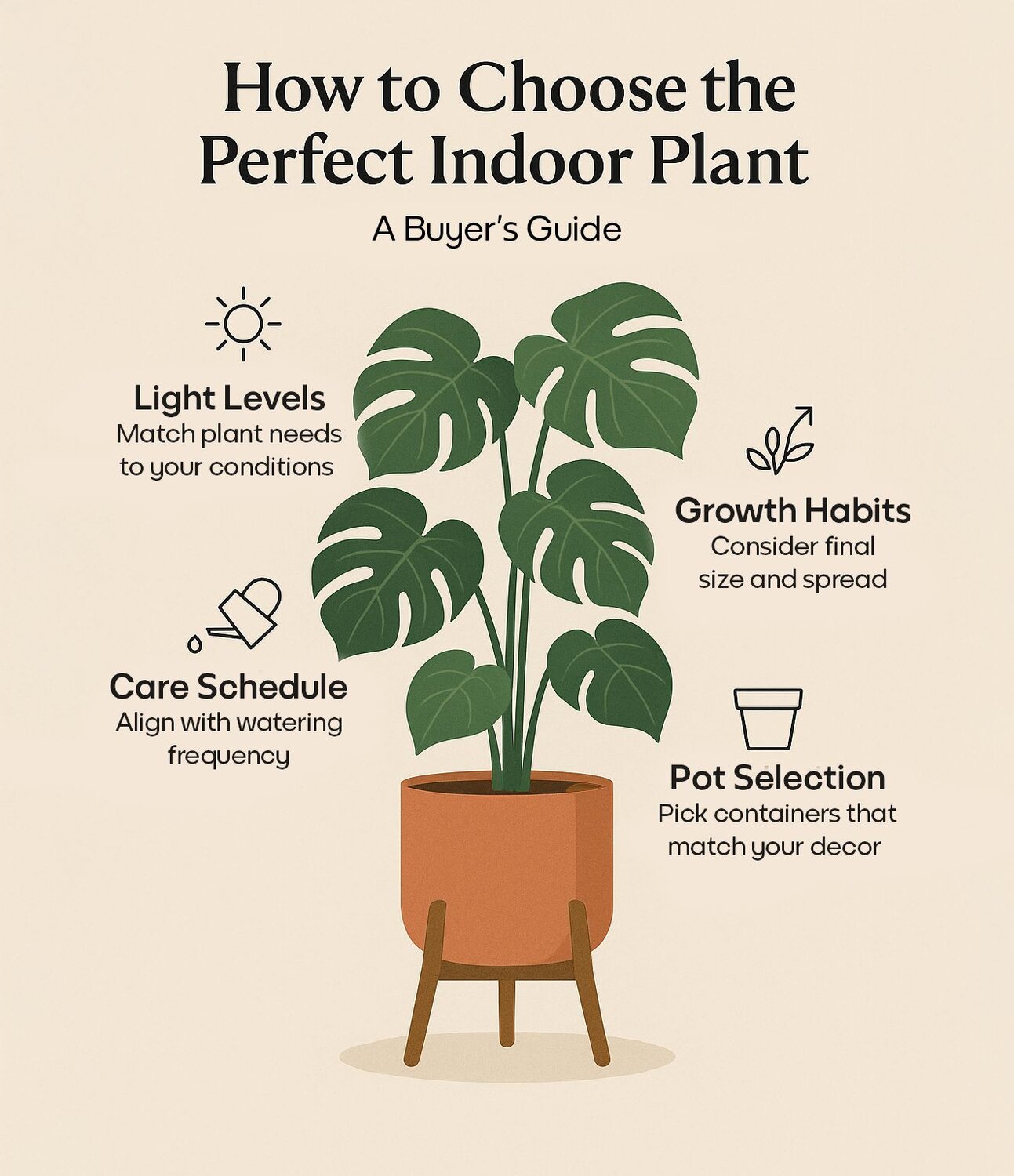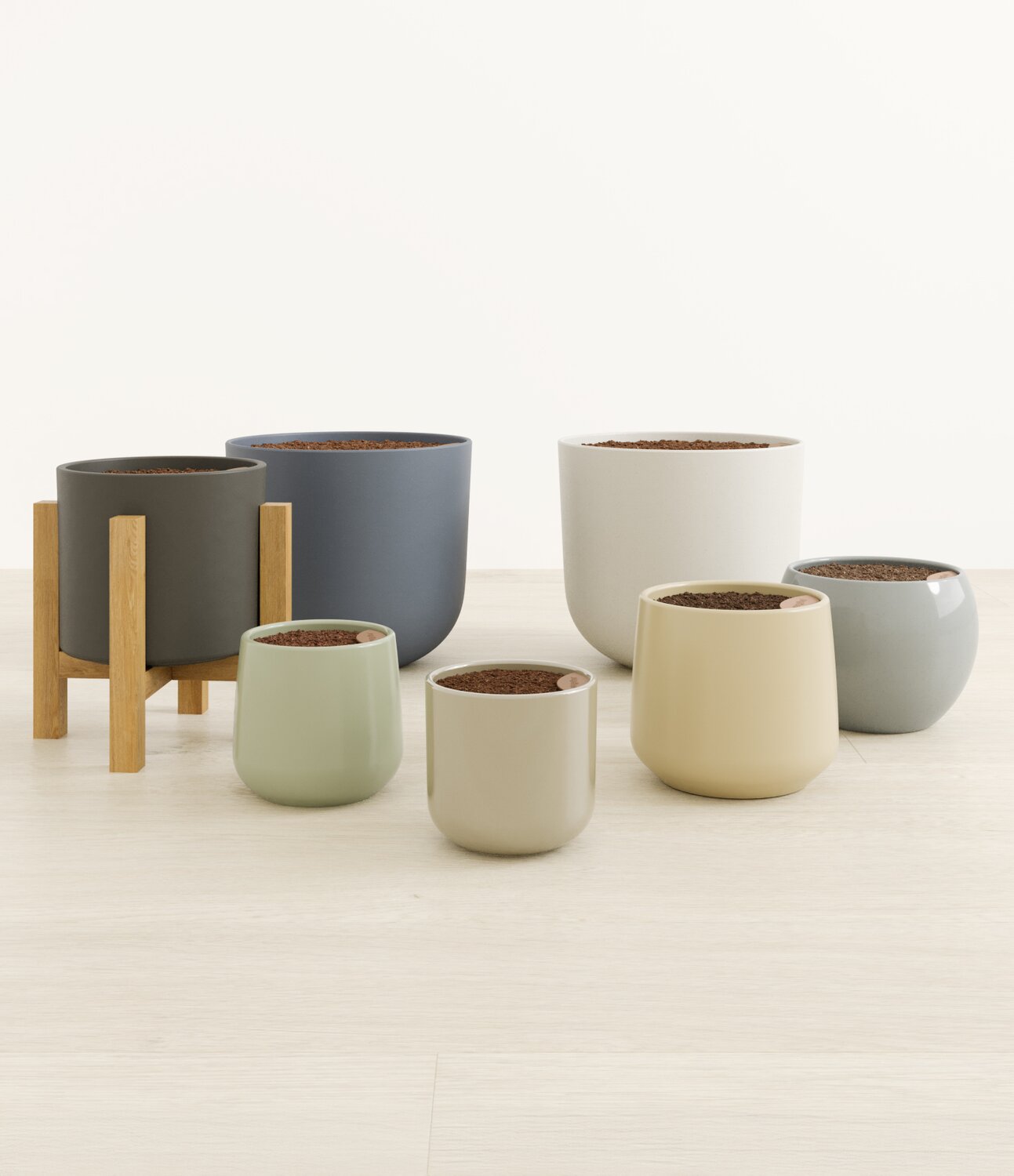How to Choose the Perfect Indoor Plant: A Buyer’s Guide
Indoor plants require thoughtful selection based on your space conditions, available time, and design preferences.
Plants differ in light requirements, growth rates, and maintenance needs, while pot styles affect how they complement your decor. Finding the right match means considering both practical care aspects and the visual impact on your home.
Choose wisely below.
Quick Tips for Indoor Plants
Follow these pointers if you’re in a hurry:
- Light levels: Match plant needs to your conditions, not what you wish you had
- Growth habits: Consider final size and spread before bringing plants home
- Care schedule: Choose plants that align with how often you can water them (see the easyplant section below for a solution)
- Pot selection: Pick containers that match your decor
- Placement strategy: Group plants with similar needs rather than scattering them
- Humidity factors: Plants have different moisture needs, with tropical varieties adapting well to humid spaces
- Pet safety: Many common houseplants contain toxins harmful to curious animals
- Popular plants: Include the Snake Plant, ZZ Plant, Cast Iron Plant, Calatheas, Pothos, and Palm varieties

The easyplant Difference
easyplant provides a self-watering pot with a reservoir and wicking system that transports water directly to the soil and roots. You fill it once a month, and it waters your plant without additional watering needs.
We created a self-watering system because, without appropriate watering schedules, new indoor plants quickly turn yellow and degrade after delivery. The result is often an indoor plant that looks ill and beyond saving.
Your easyplant has a water supply, so it is far more likely to adapt to its new home, provided you give it sufficient natural light.
Indoor Plant Light Requirements
Plants need different light levels depending on their natural growing environments. Direct light means unfiltered sun-hitting leaves, while indirect light filters through blinds or bounces off walls.
Windowsills suit sun-loving varieties that evolved in open areas, while tables across from windows work for plants preferring bright indirect light. Shelves and corners often provide low light conditions perfect for forest floor species.
You can modify too-bright spots using sheer curtains for dappled light patterns. Plants show light stress with yellowing leaves, stunted growth, or stretching toward light sources.
Here are some plant recommendations:
- Low light: Green Snake Plant
- Medium light: Parlor Palm
- Bright direct light: Anthurium
Indoor Plant Types
Plants grow in every region, and even those from moisture-rich tropical and arid desert regions can thrive indoors.
easyplant’s collections include tropical and subtropical varieties that usually grow on rainforest floors. Of course, you can also explore varieties we don’t sell elsewhere. Here’s a quick rundown of the main indoor plant types:
- Tropical: Rainforest varieties like Monsteras and Anthuriums need consistent warmth and humidity
- Subtropical: Resilient plants such as ZZ Plants and Jade Pothos that tolerate normal home conditions
- Woodland: Forest floor species, including Ferns and Spider Plants, prefer filtered light and moist soil
- Desert: Drought-resistant succulents and cacti requiring minimal water and bright conditions
- Mediterranean: Sun-loving herbs and citrus plants adapted to dry summers and mild winters
Indoor Plant Height and Spread
Plant size affects where you can place your greenery now and where it might need to move later. Every easyplant stays comfortable in its original pot for at least 18 months before needing more space.
Floor specimens like Monsteras eventually need dedicated areas away from traffic, while compact varieties can be permanently placed on shelves or tables.
Consider your room's vertical limitations before selecting varieties that reach toward ceilings. Plants that spread horizontally need clearance from neighboring objects as their foliage extends outward, creating new spatial requirements you might not anticipate.
easyplant offers small, medium, large, and huge indoor plants. We also disclose average size ranges, such as 76-91 cm tall (including pot) for the large Money Tree.
Indoor Plant Pots and Stands
Garden center plants arrive in plastic nursery pots that you can slip inside decorative containers or replace with proper pots. Proper pots that match your space will require additional investment.
Traditional terracotta pots need drainage holes to prevent roots from rotting and saucers to prevent water damage to surfaces.
Glazed pots are more stylish but also need a saucer. Regular repotting is necessary as your plants outgrow their initial containers (signs include roots growing out from the bottom of the container and no new growth).
The easyplant pot is a superior system as it has no drainage holes thanks to its built-in reservoir. Styles include Yoko, Amber, Monet, Era, and Agatha, with finishes ranging from matte to silk to shiny across numerous color options.
Additionally, you can place your plant into an easyplant stand made from bamboo to help it stand out and further protect your hard surfaces.

Positioning Indoor Plants
Place your plants away from heating vents, radiators, and air conditioners that create harmful temperature fluctuations that lead to yellowing leaves, drooping greenery, and browning at the tips of leaves.
Plants thrive with gentle air circulation while suffering near drafty doors or leaky windows that cause stress and leaf drop. Either reduce drafts or place your plants in areas protected from extreme winds.
Seasonal repositioning helps plants adapt to changing weather conditions throughout the year. Some varieties benefit from summertime outdoors but need a gradual introduction to prevent shock from sudden environmental changes.
Popular Indoor Plant Choices
Money Tree (Pet Friendly)
Palm-shaped leaves radiate from the Money Tree's slender trunk, creating a lush green canopy. It is safe for pets and perfect for beginners, bringing tropical flair without demanding special care.
Green Snake Plant (Low Light)
Shadowy corners transform with the upright Green Snake Plant's sword-like foliage. Its remarkable resilience makes it a better handler of irregular watering and forgotten care schedules than most houseplants.
Anthurium Red
Heart-shaped leaves frame the Anthurium Red's waxy crimson blooms that last for months. Medium to bright indirect light highlights its dramatic coloring against walls or in groupings.
Parlor Palm
Delicate fronds arch gracefully from the Parlor Palm's slender stems without taking up much space. Its lower light tolerance makes this palm uniquely suited for spots away from windows.
Heartleaf Philodendron (Low Light)
Heart-shaped Heartleaf Philodendron leaves spill from shelves, or they can climb a moss pole with equal vigor. Adaptable vines grow steadily with minimal care, adding movement to static spaces.
Rattlesnake Calathea (Pet Friendly)
Rattlesnake Calathea raises and lowers its distinctively patterned leaves daily, following natural light. Pet-safe foliage with purple undersides creates visual drama from multiple angles.
Marble Pothos (Low Light)
Cream marbles across each Marble Pothos leaf catch and reflect light. Trailing vines grow impressively without demanding much beyond occasional watering.
Check out all easyplant collections here.
Further reading: Easyplant's 2025 Gift Guide: Perfect Plants for Every Occasion